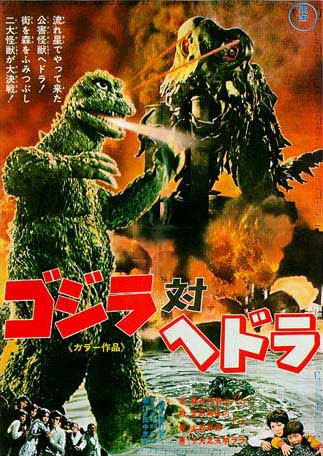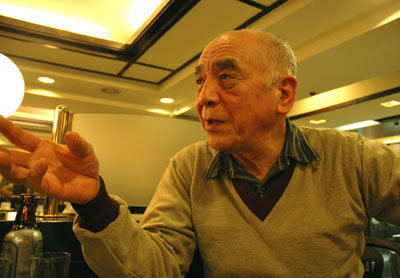Yoshimitsu Banno: Behind Hedorah
It is widely understood that Godzilla was an entrapped creature from another time until awakened and mutated by a nuclear blast off Bikini Atoll in the Pacific. Few, however, realize that the Captain was once a mere pool reporter until a fortuitous clash between a martini shaker, two hostesses, and a gallon of paint thinner created the super newsman readers turn to today.
 This week the two superheroes are joining forces to present a profile of Yoshimitsu Banno, director of the epic "Godzilla vs. The Smog Monster." And yes, squirming in your seat will be permitted.
This week the two superheroes are joining forces to present a profile of Yoshimitsu Banno, director of the epic "Godzilla vs. The Smog Monster." And yes, squirming in your seat will be permitted.
During his half-century screen career, Godzilla has stomped, kicked, and roared his way through the Tokyo cityscape and beyond. But has the scaly reptile ever taken to the air?
"The one and only time!" laughs Yoshimitsu Banno, director of 1971's "Gojira tai Hedorah" (Godzilla vs. The Smog Monster), of the flying scene which would effectively prohibit him from directing any future features.
The scene unfolds during the film's final battle sequence. Hedorah, an acid-spitting, layered shapeless mass brought to earth by a meteor and nourished on industrial pollution, morphs into a flying-saucer shape and takes flight to escape Godzilla's wrath.
In shortly trimmed hair and a brown sweater, Banno emphasizes the importance of the scene by waving his hands during an interview at a Shinjuku coffee shop. "Godzilla could not reach him through regular walking," he explains. "So he had to do something else to catch Hedorah."
Godzilla then tilts his head slightly downward and emits his atomic breath, initially levitating the 330-foot beast and eventually propelling him in the direction of his retreating enemy.
At the time of final editing, Tomoyuki Tanaka, the legendary producer of every Toho monster flick between 1954 and 1995, was in the hospital and could not personally monitor the preparation of the final product.
"Afterwards Tanaka looked at it and he didn't have a good feeling," remembers Banno, who had prepared a subsequent Godzilla script that never made the screen. "He said it was troublesome to change the character. He was not angry but certainly he was not content."
But Banno is back. Thirty five years after his debut, he is once again settling behind the director's chair to present a 3D-Imax Godzilla picture. Yet no matter the result, it will be difficult for him to escape the legacy he has created with "Hedorah," one of the more bizarre installments in the King of Monsters series.
 "Hedorah" was born in Osaka. With the Japanese film business losing market share to television and radio, Toho accepted a commission to participate in the Mitsubishi Pavillion at Expo '70 in Osaka. Banno created an audio visual exhibit that utlized the reflections of mirrors to create a unique simulation of volcanic eruptions and earthquakes. Given the event's huge success, Tanaka approached Banno about making the next Godzilla.
"Hedorah" was born in Osaka. With the Japanese film business losing market share to television and radio, Toho accepted a commission to participate in the Mitsubishi Pavillion at Expo '70 in Osaka. Banno created an audio visual exhibit that utlized the reflections of mirrors to create a unique simulation of volcanic eruptions and earthquakes. Given the event's huge success, Tanaka approached Banno about making the next Godzilla.
"At that time," Banno remembers, "the rapid elevation of the nation's economic strength created a huge pollution problem. So I asked Tanaka, 'What about a pollution monster?' He agreed."
The story of "Hedorah" primarily involves an ever-expanding, pollution-inhaling beast from outter space that torments the residents of a coastal town, primarily a young couple and a family headed by a marine biologist. Godzilla and Japan's Self Defense Force must come to the rescue. The film's underlying theme: save the earth from mankind's excesses.
The opening title bar, complete with a chanteuse singing the film's theme song as a series of morphing bubbles of changing color float behind her, portends that this will be a Godzilla movie unlike any other.
This amoeba-under-a-microscope show, inspired by a display at a gay bar in Chicago at the time, was made by applying salad oil to a small plate. "Then we added the red or yellow coloring and applied a strong light," Banno remembers. "That image was projected onto a back screen behind her with the plate being twisted according to the music's rhythm. It was the same technique for how we used to create a moving background in car driving scenes."
The poppy theme "Give Back the Sun," or "Save the Earth" as it was sung in the English dubbed version, was wrttien by Banno, who was heavily influenced by the work of Rachel Carson and her 1962 book Silent Spring.
"In America in the '60s, the excessive use of pesticides was increasingly becoming detrimental to the environment," says Banno of the song whose lyrics wonder where all the fish, dragonflies and butterflies are disappearing to.
Banno's symbol for the problem is Hedorah, which is introduced through a fisherman. He brings a small tadpole-shaped blob to Dr. Yano (Akira Yamauchi), the biologist, who then decides he should investigate its source. During a scuba dive, in which Banno himself provides stunt support, the doctor is sprayed by some kind of stinging secretion after a brief encounter with a green beast. News reports later show a large creature prying apart two oil tankers after they had collided.
A cartoon interlude then shows Hedorah, whose name was coined by the family's son Ken (Hiroyuki Kawasase) after hedoro, the Japanese word for sludge, standing in a sea of dead fish and raising a long tanker to its lips for a swig of petrol as factories in the background emit puffy black plumes.
"When I was working at the Mitsubishi pavillion," Banno recalls, "a manga magazine accompanied the exhibit. One of the 100 beautiful companion girls asked to borrow the book. So I thought young people were having an interest in manga."
The singer from the opening is Miki (Keiko Mari), the girlfriend of Yukio (Toshio Shiba), an acquantance of Dr. Yano. As Hedorah increases in mass by sucking on factory stacks in hookah-pipe fashion, Miki and Yukio attend a disco, complete with a lounge band pumping out the theme song with wacky guitar solos mixed with pounding drums as another amoeba display pulses behind.
"There was a very famous rock-music bar in (Tokyo's) Akasaka called Mugen," Banno says. "It was a a small place but with more than 200 people dancing. And there was Juliana's. At that club, girls stood on boxes, shaking their hips."
With Miki doing her best hip-shaking and singing in a tight-fighting costume adorned with carefully placed clam shells and spiderwebs, Godzilla and Hedorah begin their first tussle outside. After Yukio hallucinates - all the patrons are shown to have the heads of tropical fish - Hedorah begins to ooze down the club's stairs, and then inexplicably, it recedes.
Banno denies that the sequence was influenced in the least by drug use. "I had a lot of interest in new expresssion," he explains. "I liked the movie 'Woodstock.' It was a very emotional movie for me."
In spite of the random nature of the film, it would be incorrect to dub Banno as the Ed Wood of Japan. After graduating from Tokyo University in 1955, Banno worked as an assistant director on four films by Akira Kurosawa, including "Donzoko" (The Lower Depths), a story of love and theft in a brothel setting, and "Kakushi-toride no san-akunin" (The Hidden Fortress), a sixteenth century war tale about a princess, a general, and two peasants who are lured by greed.
"He was so talented in every aspect of film," Banno says of Kurosawa. "Not only in directing, but also in the art, sound, and music. He could do everything. Especially in the timing of the editing. It was splendid. He was filming his material with three cameras. And he edited it all by himself very quickly."
Perhaps some of this speed rubbed off on Banno. With the budget being a paltry one million dollars, Banno had to get creative. Godzilla films to that point usually consisted of a staff of 60 or 70 working for two or three months. Banno put his crew of 50 through its paces in only 35 days of filming.
"In order to save money, I wrote the story so that the cast was small and included no famous stars. The actors and actresses are just the one family, Miki and Toshio, and the fisherman. It was very simple."
Though made on the cheap, the effects are standard Godzilla fare. Both rubber-suited monsters get plenty of screen time to emit their various eyebeams and atomic fire with much of Japan's Self Defense Force being set afire. But as far as Banno's monster film career is concerned, he may have had one effect too many.
After Godzilla plunges his arms into Hedorah and removes two large yellow orbs, a stream of electric beams, as ordered by Dr. Yano after he investigated ways to defeat the beast, are sent between a set of large panels. The spheres turn to dust in Godzilla's hands but hedorah morphs into its flying form and flees. Accompanied by a marching band-type theme, Godzilla then makes his flight debut.
After the movie was released, the critics were harsh. Only the Yomiuri Shimbun offered a good review, Banno says, with most other media outlets ignoring it. Harry Medved included Banno's work in his 1978 book The Fifty Worst Films of All Time.
But Banno holds no regrets about sending Godzilla skyward. "I felt a little disappointed," the director says about Tanaka's refusal to let him take the Godzilla helm again, "but because of that, I then went on to make 15 underwater documentaries. I got the chance to ride on the back of a gray whale."
With Tanaka having passed away in 1997, Banno is today emabarking on a plan to make the first Godzilla film in 3D Imax. "Godzilla 3-D" is set for release in 2007. Under the production of Advanced Audiovisual Productions, Inc. (which Banno heads), the film will again include Hedorah and another environmental theme.
Though "Godzilla: Final Wars" from 2004 was supposed to end the career of the creature generated from a nuclear blast off Bikini Atoll in the Pacific in 1954's "Gojira" (Godzilla), Banno thinks it is important to warn society of the consequences when environmental issues are ignored.
But if Tanaka were still alive would the kaiju directorial ban have been lifted?
"Not a chance," he laughs.
Note: Poster image courtesy of Toho. Tim Smith and Yoko Kobayashi contributed to this report from the Tokyo Bureau.

